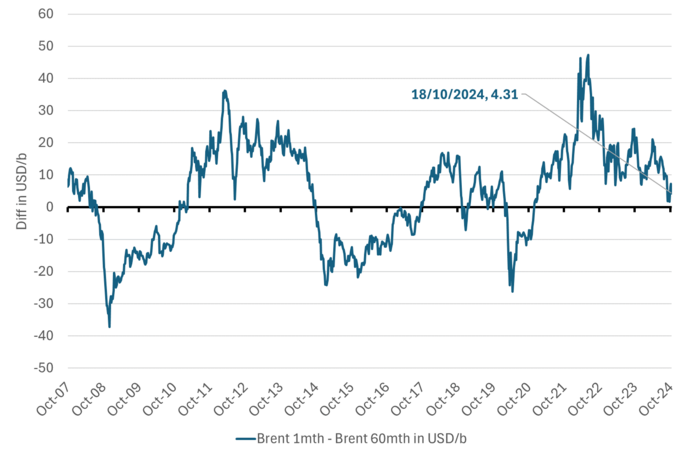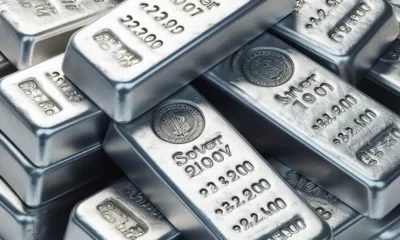Analys
Crude oil comment: Market battling between spike-risk versus 2025 surplus

Brent crude falls back as day by day goes by with no Israeli retaliation. Market focus returns to concerns for surplus in 2025. Brent crude fell 7.6% last week following a rally to USD 81.16/b the week before when it felt like a retaliatory attack by Israel on Iran was imminent with all targets possible. Israel has promised that ”Iran will pay” for its attack on Israel on 1 October when it fired 200 ballistic missiles at Israel.
But days passed by and no retaliation happened. Fears that Israel will go after Iranian oil installations and nuclear facilities also seems to have faded. Biden has urged Israel to not hit such targets. Israel has said that it will make its own choices so it is still an open risk that Israel could indeed hit Iranian oil installations.
Last week we had yet another report from the IEA where it predicts that OPEC must cut yet another 0.9 mb/d in 2025 to keep the market in balance. That keeps the fear going for lower oil prices in 2025. All in all Brent fell back 7.6% last week to a close on Friday at USD 73.06/b.
This morning it is back up to USD 73.3/b (+0.4%) which is not much and less than the 1% gain in industrial metals. So most likely it has very little to do with increased fears for an Israeli retaliation.
To us it seems like close to certain that Israel will indeed retaliate at some point. Likely hard and forceful and not a muted retaliation like in April. Leaked US intelligence documents over the weekend show rather extensive Israeli preparations for a retaliation on Iran involving three Israeli airfields including F-15s and refueling aircrafts. So market today most likely also thinks that the Israeli retaliation will come and a hard one as well. If so it will likely lead to yet another re-retaliation by Iran with a risk for spiraling effects which in the end could involve Iranian oil installations etc., etc.
But as long as nothing happens on a day to day basis, the oil price falls back with market focus circling back to concerns over a surplus of oil in 2025 where OPEC needs to cut another 0.9 mb/d to keep it in balance according to the latest report from the IEA. Though only 0.7 mb/d if FSU production is unchanged. OPEC+ planning to add barrels to the market from December onward makes that look even worse of course.
From backwardation-market in 2022/23/24 to contango-market in 2025? Over the past three years the oil market has been running tight. Tight on products and tight on crude. The long-dated Brent crude five year contract, or the 60 month contract, has been very stable at close to USD 70/b. The front-end Brent crude contract however has traded at a premium of USD 28/b, USD 15/b and USD 12/b for 2022, 2023 and 2024 respectively versus the 60 month contract.
If the oil market next year flips to a surplus with rising inventories then the market should naturally flip to a contango-market. The implication of that is that the front-end Brent contract will trade at a discount to the longer dated Brent price. The Brent 1 month price would then typically be USD 70/b (long-dated 60mth price) minus some discount of maybe USD 5-10/b. Implying a Brent 1 month price of USD 60-65/b. This is what the oil bears are eyeing for 2025 and why we have seen such overly bearish positioning lately.
Counter to such a development would be possible damage to Iranian oil supplies due to the forthcoming Israeli retaliation. Or in the following re-re-re-re-retaliations after that. Or that Donald Trump is elected president and more strictly enforces sanctions on Iranian oil exports thus making room for more exports from the rest of OPEC+.
Brent crude 1mth contract minus the 60mth contract. Market shifting between contango-market (negative) and backwardation-market (positive).

Brent crude 1mth contract minus the 60mth contract. Market shifting between contango-market (negative) and backwardation-market (positive).

Analys
Brent needs to fall to USD 58/b to make cheating unprofitable for Kazakhstan

Brent jumping 2.4% as OPEC+ lifts quota by ”only” 411 kb/d in July. Brent crude is jumping 2.4% this morning to USD 64.3/b following the decision by OPEC+ this weekend to lift the production cap of ”Voluntary 8” (V8) by 411 kb/d in July and not more as was feared going into the weekend. The motivation for the triple hikes of 411 kb/d in May and June and now also in July has been a bit unclear: 1) Cheating by Kazakhstan and Iraq, 2) Muhammed bin Salman listening to Donald Trump for more oil and a lower oil price in exchange for weapons deals and political alignments in the Middle East and lastly 3) Higher supply to meet higher demand for oil this summer. The argument that they are taking back market share was already decided in the original plan of unwinding the 2.2 mb/d of V8 voluntary cuts by the end of 2026. The surprise has been the unexpected speed with monthly increases of 3×137 kb/d/mth rather than just 137 kb/d monthly steps.

No surplus yet. Time-spreads tightened last week. US inventories fell the week before last. In support of point 3) above it is worth noting that the Brent crude oil front-end backwardation strengthened last week (sign of tightness) even when the market was fearing for a production hike of more than 411 kb/d for July. US crude, diesel and gasoline stocks fell the week before last with overall commercial stocks falling 0.7 mb versus a normal rise this time of year of 3-6 mb per week. So surplus is not here yet. And more oil from OPEC+ is welcomed by consumers.
Saudi Arabia calling the shots with Russia objecting. This weekend however we got to know a little bit more. Saudi Arabia was predominantly calling the shots and decided the outcome. Russia together with Oman and Algeria opposed the hike in July and instead argued for zero increase. What this alures to in our view is that it is probably the cheating by Kazakhstan and Iraq which is at the heart of the unexpectedly fast monthly increases. Saudi Arabia cannot allow it to be profitable for the individual members to cheat. And especially so when Kazakhstan explicitly and blatantly rejects its quota obligation stating that they have no plans of cutting production from 1.77 mb/d to 1.47 mb/d. And when not even Russia is able to whip Kazakhstan into line, then the whole V8 project is kind of over.
Is it simply a decision by Saudi Arabia to unwind faster altogether? What is still puzzling though is that despite the three monthly hikes of 411 kb/d, the revival of the 2.2 mb/d of voluntary production cuts is still kind of orderly. Saudi Arabia could have just abandoned the whole V8 project from one month to the next. But we have seen no explicit communication that the plan of reviving the cuts by the end of 2026 has been abandoned. It may be that it is simply a general change of mind by Saudi Arabia where the new view is that production cuts altogether needs to be unwinded sooner rather than later. For Saudi Arabia it means getting its production back up to 10 mb/d. That implies first unwinding the 2.2 mb/d and then the next 1.6 mb/d.
Brent would likely crash with a fast unwind of 2.2 + 1.6 mb/d by year end. If Saudi Arabia has decided on a fast unwind it would meant that the group would lift the quotas by 411 kb/d both in August and in September. It would then basically be done with the 2.2 mb/d revival. Thereafter directly embark on reviving the remaining 1.6 mb/d. That would imply a very sad end of the year for the oil price. It would then probably crash in Q4-25. But it is far from clear that this is where we are heading.
Brent needs to fall to USD 58/b or lower to make it unprofitable for Kazakhstan to cheat. To make it unprofitable for Kazakhstan to cheat. Kazakhstan is currently producing 1.77 mb/d versus its quota which before the hikes stood at 1.47 kb/d. If they had cut back to the quota level they might have gotten USD 70/b or USD 103/day. Instead they choose to keep production at 1.77 mb/d. For Saudi Arabia to make it a loss-making business for Kazakhstan to cheat the oil price needs to fall below USD 58/b ( 103/1.77).
Analys
All eyes on OPEC V8 and their July quota decision on Saturday

Tariffs or no tariffs played ping pong with Brent crude yesterday. Brent crude traded to a joyous high of USD 66.13/b yesterday as a US court rejected Trump’s tariffs. Though that ruling was later overturned again with Brent closing down 1.2% on the day to USD 64.15/b.

US commercial oil inventories fell 0.7 mb last week versus a seasonal normal rise of 3-6 mb. US commercial crude and product stocks fell 0.7 mb last week which is fairly bullish since the seasonal normal is for a rise of 4.3 mb. US crude stocks fell 2.8 mb, Distillates fell 0.7 mb and Gasoline stocks fell 2.4 mb.
All eyes are now on OPEC V8 (Saudi Arabia, Iraq, Kuwait, UAE, Algeria, Russia, Oman, Kazakhstan) which will make a decision tomorrow on what to do with production for July. Overall they are in a process of placing 2.2 mb/d of cuts back into the market over a period stretching out to December 2026. Following an expected hike of 137 kb/d in April they surprised the market by lifting production targets by 411 kb/d for May and then an additional 411 kb/d again for June. It is widely expected that the group will decide to lift production targets by another 411 kb/d also for July. That is probably mostly priced in the market. As such it will probably not have all that much of a bearish bearish price impact on Monday if they do.
It is still a bit unclear what is going on and why they are lifting production so rapidly rather than at a very gradual pace towards the end of 2026. One argument is that the oil is needed in the market as Middle East demand rises sharply in summertime. Another is that the group is partially listening to Donald Trump which has called for more oil and a lower price. The last is that Saudi Arabia is angry with Kazakhstan which has produced 300 kb/d more than its quota with no indications that they will adhere to their quota.
So far we have heard no explicit signal from the group that they have abandoned the plan of measured increases with monthly assessments so that the 2.2 mb/d is fully back in the market by the end of 2026. If the V8 group continues to lift quotas by 411 kb/d every month they will have revived the production by the full 2.2 mb/d already in September this year. There are clearly some expectations in the market that this is indeed what they actually will do. But this is far from given. Thus any verbal wrapping around the decision for July quotas on Saturday will be very important and can have a significant impact on the oil price. So far they have been tightlipped beyond what they will do beyond the month in question and have said nothing about abandoning the ”gradually towards the end of 2026” plan. It is thus a good chance that they will ease back on the hikes come August, maybe do no changes for a couple of months or even cut the quotas back a little if needed.
Significant OPEC+ spare capacity will be placed back into the market over the coming 1-2 years. What we do know though is that OPEC+ as a whole as well as the V8 subgroup specifically have significant spare capacity at hand which will be placed back into the market over the coming year or two or three. Probably an increase of around 3.0 – 3.5 mb/d. There is only two ways to get it back into the market. The oil price must be sufficiently low so that 1) Demand growth is stronger and 2) US shale oil backs off. In combo allowing the spare capacity back into the market.
Low global inventories stands ready to soak up 200-300 mb of oil. What will cushion the downside for the oil price for a while over the coming year is that current, global oil inventories are low and stand ready to soak up surplus production to the tune of 200-300 mb.
Analys
Brent steady at $65 ahead of OPEC+ and Iran outcomes

Following the rebound on Wednesday last week – when Brent reached an intra-week high of USD 66.6 per barrel – crude oil prices have since trended lower. Since opening at USD 65.4 per barrel on Monday this week, prices have softened slightly and are currently trading around USD 64.7 per barrel.

This morning, oil prices are trading sideways to slightly positive, supported by signs of easing trade tensions between the U.S. and the EU. European equities climbed while long-term government bond yields declined after President Trump announced a pause in new tariffs yesterday, encouraging hopes of a transatlantic trade agreement.
The optimisms were further supported by reports indicating that the EU has agreed to fast-track trade negotiations with the U.S.
More significantly, crude prices appear to be consolidating around the USD 65 level as markets await the upcoming OPEC+ meeting. We expect the group to finalize its July output plans – driven by the eight key producers known as the “Voluntary Eight” – on May 31st, one day ahead of the original schedule.
We assign a high probability to another sizeable output increase of 411,000 barrels per day. However, this potential hike seems largely priced in already. While a minor price dip may occur on opening next week (Monday morning), we expect market reactions to remain relatively muted.
Meanwhile, the U.S. president expressed optimism following the latest round of nuclear talks with Iran in Rome, describing them as “very good.” Although such statements should be taken with caution, a positive outcome now appears more plausible. A successful agreement could eventually lead to the return of more Iranian barrels to the global market.
-

 Nyheter4 veckor sedan
Nyheter4 veckor sedanUtbudsunderskott och stigande industriell efterfrågan av silver på marknaden
-

 Nyheter4 veckor sedan
Nyheter4 veckor sedanNystart för koppargruvan Viscaria i Kiruna – en av Europas största
-

 Analys3 veckor sedan
Analys3 veckor sedanRebound to $65: trade tensions ease, comeback in fundamentals
-

 Analys3 veckor sedan
Analys3 veckor sedanOil slips as Iran signals sanctions breakthrough
-

 Nyheter2 veckor sedan
Nyheter2 veckor sedanFörenade Arabemiraten siktar på att bygga ett datacenter på 5 GW, motsvarande fem stora kärnkraftsreaktorer
-

 Analys4 veckor sedan
Analys4 veckor sedanWhipping quota cheaters into line is still the most likely explanation
-

 Analys2 veckor sedan
Analys2 veckor sedanA lower oil price AND a softer USD will lift global appetite for oil
-

 Nyheter3 veckor sedan
Nyheter3 veckor sedanStark affär för Pan American – men MAG Silvers aktieägare kan bli förlorare











